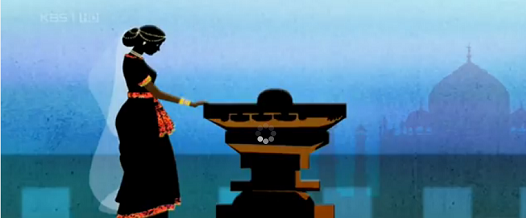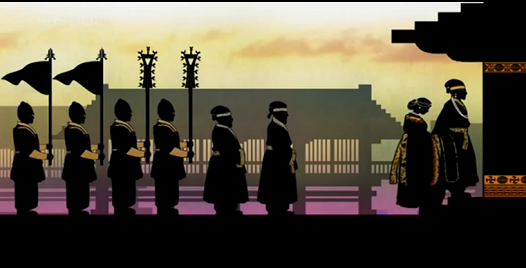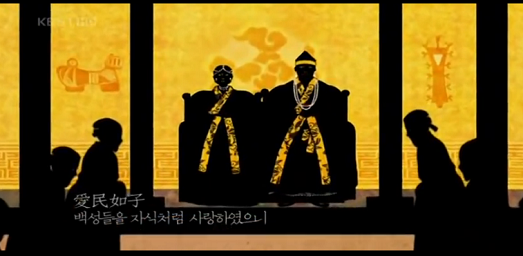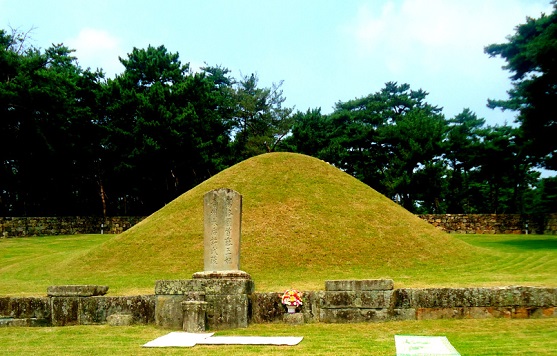The Karak clan of Queen Hwang-ok/ Suri Ratna
| Line 14: | Line 14: | ||
= Suri Ratna Mishr= | = Suri Ratna Mishr= | ||
| − | [[File: Princess Suriratna.png| Princess | + | [[File: Princess Suriratna.png| Princess Suriratna in India(Animation by: [https://www.youtube.com/watch?v=_zGKqqseuHw SNSD TV] )|frame| left|500px]] |
| − | [[File: enters the boat | + | [[File: She enters the boat moored on some Indian coast and bound for Korea. Her entourage includes camels.png|… enters the boat with her entourage including camels, c. A.D. 48. (Note the Mughal-style, 15th – 17th century tombs in the background.) (Animation by S.Korea’s [https://www.youtube.com/watch?v=_zGKqqseuHw SNSD TV]) |frame|500px]] |
[[File: The boat to Korea sails through the monsoon rains.png| The boat to Korea sails through the monsoon rains. Animation by: [https://www.youtube.com/watch?v=_zGKqqseuHw SNSD TV] |frame| left|500px]] | [[File: The boat to Korea sails through the monsoon rains.png| The boat to Korea sails through the monsoon rains. Animation by: [https://www.youtube.com/watch?v=_zGKqqseuHw SNSD TV] |frame| left|500px]] | ||
[[File: The Indian princess meets the King of Gaya (Korea).png| The Indian princess meets the King of Gaya (Korea). Animation by: [https://www.youtube.com/watch?v=_zGKqqseuHw SNSD TV] |frame|500px]] | [[File: The Indian princess meets the King of Gaya (Korea).png| The Indian princess meets the King of Gaya (Korea). Animation by: [https://www.youtube.com/watch?v=_zGKqqseuHw SNSD TV] |frame|500px]] | ||
[[File: The newly-wed couple enters the royal palace in Gaya (Korea).png| The newly-wed couple enters the royal palace in Gaya (Korea). Animation by: [https://www.youtube.com/watch?v=_zGKqqseuHw SNSD TV] |frame| left|500px]] | [[File: The newly-wed couple enters the royal palace in Gaya (Korea).png| The newly-wed couple enters the royal palace in Gaya (Korea). Animation by: [https://www.youtube.com/watch?v=_zGKqqseuHw SNSD TV] |frame| left|500px]] | ||
[[File: They rule the kingdom of Gaya.png| They rule the kingdom of Gaya and live happily ever after. Animation by: [https://www.youtube.com/watch?v=_zGKqqseuHw SNSD TV] |frame|500px]] | [[File: They rule the kingdom of Gaya.png| They rule the kingdom of Gaya and live happily ever after. Animation by: [https://www.youtube.com/watch?v=_zGKqqseuHw SNSD TV] |frame|500px]] | ||
| − | [[File: King Suro.png| King Suro. Animation by: [https://www.youtube.com/watch?v=_zGKqqseuHw SNSD TV] |frame | + | [[File: King Suro.png| King Suro. Animation by: [https://www.youtube.com/watch?v=_zGKqqseuHw SNSD TV] |frame| 500px]] |
The Mishr(a) clan ruled the Kingdom of Kosal(a) (the present Ayodhya area of India) in the 1st century A.D. King Mishr had a dream that the King of Geumgwan Gaya (in Korea) was single and was looking for a wife. | The Mishr(a) clan ruled the Kingdom of Kosal(a) (the present Ayodhya area of India) in the 1st century A.D. King Mishr had a dream that the King of Geumgwan Gaya (in Korea) was single and was looking for a wife. | ||
| Line 37: | Line 37: | ||
King Kim Suro founded the Gaya Kingdom (57 B.C./ A.D.42 – A.D. 668) in the southeastern part of the Korean Peninsula. Korea’s Gaya was where Gimhae in the South Gyeongsang Province now is. | King Kim Suro founded the Gaya Kingdom (57 B.C./ A.D.42 – A.D. 668) in the southeastern part of the Korean Peninsula. Korea’s Gaya was where Gimhae in the South Gyeongsang Province now is. | ||
| + | |||
| + | A short animated Korean version of the love story can be seen on [https://www.youtube.com/watch?v=_zGKqqseuHw youtube] | ||
=The Karak clan= | =The Karak clan= | ||
The Karak clan of South Korea traces its ancestry to Suri Ratna and are her descendants. Kim Suro started the Karak clan in A.D. 48. The Indo-Korean royal couple had ten sons and two daughters. Two of the sons adopted their mother's family name (Huh/ Hoon) as translated into Korean. | The Karak clan of South Korea traces its ancestry to Suri Ratna and are her descendants. Kim Suro started the Karak clan in A.D. 48. The Indo-Korean royal couple had ten sons and two daughters. Two of the sons adopted their mother's family name (Huh/ Hoon) as translated into Korean. | ||
| Line 47: | Line 49: | ||
In 2012 when the then Indian Prime Minister Manmohan Singh visited South Korea, his wife Gursharan Kaur asked Indian Ambassador Vishnu Prakash how many Indians lived in Korea. Prakash assumed that Mrs Kaur meant PIOs/ OCIs and NRIs. So, he said that there was a community of about seven to eight thousand Indians. But Korean President Lee Myung-Bak's wife, Kim Yoon-ok, corrected him by saying he was ill-informed and the number was 5 million (50 lakh) and that she (Kim Yoon-ok) herself was one of them. | In 2012 when the then Indian Prime Minister Manmohan Singh visited South Korea, his wife Gursharan Kaur asked Indian Ambassador Vishnu Prakash how many Indians lived in Korea. Prakash assumed that Mrs Kaur meant PIOs/ OCIs and NRIs. So, he said that there was a community of about seven to eight thousand Indians. But Korean President Lee Myung-Bak's wife, Kim Yoon-ok, corrected him by saying he was ill-informed and the number was 5 million (50 lakh) and that she (Kim Yoon-ok) herself was one of them. | ||
| + | |||
| + | In India it is a matter of great satisfaction that the Indians and more than 10% of Koreans share the same blood and genes--and the Indians and ''all'' Koreans share the same liberal democratic values. | ||
=Monuments…= | =Monuments…= | ||
==…in Ayodhya== | ==…in Ayodhya== | ||
Revision as of 15:39, 26 October 2014
You can help convert this 'stub' into an encyclopedia-style entry, |
Contents |
Suri Ratna Mishr






The Mishr(a) clan ruled the Kingdom of Kosal(a) (the present Ayodhya area of India) in the 1st century A.D. King Mishr had a dream that the King of Geumgwan Gaya (in Korea) was single and was looking for a wife.
Around the same time an oracle asked the King of Korea’s Gaya kingdom to await the coming of a princess from ‘Ayodia,’ the capital of the Kosala Kingdom.
King Kim Suro (or Sureung) had founded the Karak kingdom in A.D. 42, with its capital at Gimhae city. (According to some it was founded in 57 B.C.)
King Mishr asked his daughter Princess Suri Ratna (‘brown gem stone’) to set sail for Korea. This would not have been easy because Ayodhya is hundreds of miles from the nearest seashore. So, King Mishr sent a fair-sized retinue to accompany his daughter. The journey by sea took three months.
The Indian princess reached Korea in A.D. 48
A rival Korean king and ‘other whimsical elements’ tried their best to prevent the divinely ordained couple from marrying. However, the blessings of a Buddhist pagoda built by Lord Buddha himself ensured that the predictions came true and King Kim Suro married the Indian princess. She is renowned in Korea as Queen Huh (or Hur or Heo) Hwang-ok.
These facts have been recorded on four pages of the Garakguk-gi section of the voluminous Samguk Yusa ("The Heritage History of the Three Kingdoms"), written in the 1200s. These four pages are an account of the marriage of Kim Su-ro.
King Kim Suro founded the Gaya Kingdom (57 B.C./ A.D.42 – A.D. 668) in the southeastern part of the Korean Peninsula. Korea’s Gaya was where Gimhae in the South Gyeongsang Province now is.
A short animated Korean version of the love story can be seen on youtube
The Karak clan
The Karak clan of South Korea traces its ancestry to Suri Ratna and are her descendants. Kim Suro started the Karak clan in A.D. 48. The Indo-Korean royal couple had ten sons and two daughters. Two of the sons adopted their mother's family name (Huh/ Hoon) as translated into Korean.
The First Lady of S Korea Mrs. Kim Yoon-ok; former President Kim Dae-jung; former President Kim Young-sam and former PM Kim Jong-pil belong to this clan. Uk Heo who co-authored South Korea's Rise: Economic Development, Power and Foreign Relations (Cambridge University Press), too, is a descendant.
Indeed, almost all Koreans with the surnames Kim and Huh/ Hoon/ Heo from Gimhae and Lee from Incheon belong to the Karak clan and are descendants of Suri Ratna. This clan of a little less than 60 lakh (6 million) people accounts for more than a tenth of Korea’s population of 5 crore (50 million) in 2014.
Till the early 1900s the Kims and Heos did not inter-marry, as is the Indo-Korean tradition of not marrying within the clan.
In 2012 when the then Indian Prime Minister Manmohan Singh visited South Korea, his wife Gursharan Kaur asked Indian Ambassador Vishnu Prakash how many Indians lived in Korea. Prakash assumed that Mrs Kaur meant PIOs/ OCIs and NRIs. So, he said that there was a community of about seven to eight thousand Indians. But Korean President Lee Myung-Bak's wife, Kim Yoon-ok, corrected him by saying he was ill-informed and the number was 5 million (50 lakh) and that she (Kim Yoon-ok) herself was one of them.
In India it is a matter of great satisfaction that the Indians and more than 10% of Koreans share the same blood and genes--and the Indians and all Koreans share the same liberal democratic values.
Monuments…
…in Ayodhya
On the 6th March 2001 the Karak Clan Society built a monument at Ayodhya on the west bank of River Saryu, in cooperation with the state government of Uttar Pradesh. he North Korean ambassador to India was among those present. Since then members of the Karak Clan Society, and often Government officials from Gimhae City (South Korea), have visited the site every March to celebrate the Queen’s anniversary. Often a traditional Korean dancing team has participated in the ceremony.
In 2014 India’s Ministry of Tourism gave the government of Uttar Pradesh a grant, with the request to build a Korean-style monument within the same site in order to strengthen India’s ties with S. Korea and give the Karak Clan a sense of belonging in Ayodhya.
…in Korea
Queen Huh's tomb has a pagoda in front, built with stones that she is believed to have brought from Ayodhya.
Efforts by Indian envoys
India’s Ambassador to S. Korea (2005 and 2008), N. Parthasarathi, first heard the story when President Roh Moo-hyun visited India in 2004.
This led to extensive research and a voyage of discovery, which he distilled into the novel Silk and Empress/ The Legend of Ayodhya Princess in Korea."